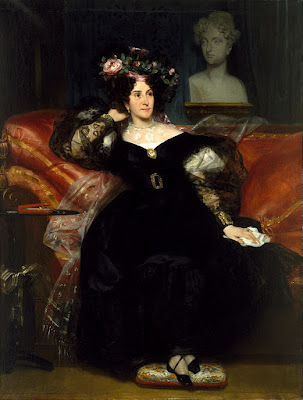 |
| Rosalba Carriera Portrait of Caterina Sagredo Barbarigo of Venice ca. 1735-40 pastel Gemäldegalerie Alte Meister, Dresden |
"It would have been impossible to say whether she blamed, whether she approved, whether she knew or did not know about these things. Her features no longer bore any relation to anything except one another. Her nose, her mouth, her eyes, formed a perfect harmony, isolated from everything else; she looked like a pastel, and seemed to have no more heard what had just been said than if it had been uttered in front of a portrait by La Tour."
 |
| Andrea Soldi Portrait of Thomas Barrett Lennard, 17th Lord Dacre ca. 1736-44 oil on canvas Museum of Fine Arts, Houston |
 |
| Carle Van Loo Portrait of Marie Leszczinska, Queen of France 1747 oil on canvas Palace of Versailles |
 |
| Jean-Baptiste Van Loo Portrait of Louis XV 1723 oil on canvas Palace of Versailles |
 |
| Thomas Gainsborough Portrait of Mary Little, later Lady Carr ca. 1763 oil on canvas Yale Center for British Art |
"Then presently, whether it be in music or in literature or in painting, other works come along, works that may even be the very opposite of the ones which they supersede. For the ability to launch ideas and systems – and still more of course the ability to assimilate them – has always been much commoner than genuine taste, even among those who themselves produce works of art, and with the multiplication of reviews and literary journals (and with them of factitious vocations as writer or artist) has become very much more widespread. Not so long ago, for instance, the best part of the younger generation, the most intelligent and the most disinterested of them, through a change of fashion admired nothing but works with a lofty moral and sociological, and even religious, significance. This they imaged to be the criterion of a work's value, renewing the old error of David and Chenavard and Brunetière and all those who in the past thought like them. . . . The truth is that as soon as the reasoning intelligence takes upon itself to judge works of art, nothing is any longer fixed or certain: you can prove anything you wish to prove."
 |
| Johan Zoffany Portrait of Mrs Woodhull ca. 1770 oil on canvas Tate Britain |
 |
| Thomas Lawrence Portrait of Lord Amherst 1821 oil on canvas Toledo Museum of Art |
 |
| Anton Raphael Mengs Portrait of Isabel de Parreño y Arce, Marquesa de Llano ca. 1775 oil on canvas Real Academia de Bellas Artes de San Fernando Madrid |
 |
| Francisco Goya Portrait of the matador Pedro Romero ca. 1795-98 oil on canvas Kimbell Art Museum, Fort Worth, Texas |
"Through art alone we are able to emerge from ourselves, to know what another person sees of a universe which is not the same as our own and of which, without art, the landscapes would remain as unknown to us as those that may exist on the moon. Thanks to art, instead of seeing one world only, our own, we see that world multiply itself and we have at our disposal as many worlds as there are original artists, worlds more different one from the other than those which revolve in infinite space, worlds which, centuries after the extinction of the fire from which their light first emanated, whether it is called Rembrandt or Vermeer, send us still each one its special radiance."
 |
| Eugène Devéria Portrait of Madame Jules-Antoine Droz 1833 oil on canvas Museum of Fine Arts, Houston |
 |
| Édouard Manet Portrait of Monsieur Brun 1879 oil on canvas National Museum of Western Art, Tokyo |
 |
| John Singer Sargent Portrait of Mrs Carl Meyer and her children 1896 oil on canvas Tate Britain |
 |
| Louis Anquetin Woman on the Champs Élysées by night ca. 1889-93 oil on canvas Van Gogh Museum, Amsterdam |
"He was soon followed by M. Verdurin, whose death caused grief to one person only and that, strangely enough, was Elstir. For whereas I had been able to study Elstir's work from a point of view which was to some extent objective, the painter himself, particularly as he grew older, linked it superstitiously to the society which had provided him with models and which had also, after thus transforming itself within him through the alchemy of impressions into a work of art, given him his public, his spectators. More and more he was inclined to believe materialistically that a not inconsiderable part of beauty is inherent in objects, and just as, at the beginning, he had adored in Mme. Elstir the archetype of that rather heavy beauty which he had pursued and caressed in his paintings and in tapestries, so now in the death of M. Verdurin he saw the disappearance of one of the last relics of the social framework, the perishable framework – as quick to crumble away as the very fashions in clothes which form part of it – which supports an art and certifies its authenticity, and he was as saddened and distressed by this event as a painter of fêtes galantes might have been by the Revolution which destroyed the elegances of the eighteenth century, or Renoir by the disappearance of Montmartre and the Moulin de la Galette . . . "
 |
| Ernst Josephson Spanish Blacksmiths 1882 oil on canvas National Gallery of Norway, Oslo |
– quoted passages are from Remembrance of Things Past by Marcel Proust, originally published between 1913 and 1927